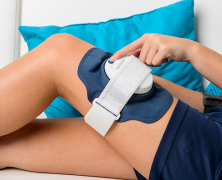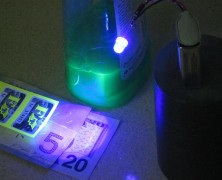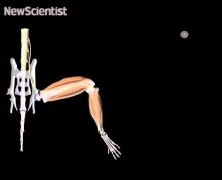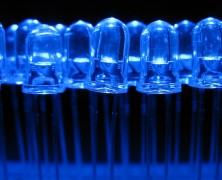Philips has announced the release of a wearable device that uses blue LED light to manage mild to moderate cases of psoriasis vulgaris. The device, which will be available through distributors this month in Germany, Netherlands and the U.K., is called Philips BlueControl and will offer an effective form of treatment for the skin condition without requiring medication. Psoriasis is a skin condition that effects 125 million people across the planet. Of those suffering from the condition, 80% have the most common form, psoriasis vulgaris. Also known as plaque psoriasis, the condition causes plaques on the skin in the form of red raised skin and flakey “scales” that arise when the skin cells die. Symptoms of the condition include itching, pain and cracking. Needless to say, the physical and psychological effects can be debilitating for those patients suffering from this disease. While the precise causes of psoriasis are unknown, it’s generally accepted that the condition arises following damage to the immune system, enzymes and other materials, which leads to uncontrollable growth of keratinocytes (immature skin cells that produce keratin, a tough protein found in nails, hair and skin) that triggers the skin flakes and inflammation as the body works to rid itself of the growth. Existing treatments to reduce the symptoms of the condition include topical applications, prescription drugs and UV phototheraphy—a treatment which taxes patients and medical services by requiring frequent visits to doctors’ offices. Looking for a better way to treat this incurable condition, researchers have found simple LED blue light treatment slows rapid cell division and can also reduce inflammation, which are the root causes of psoriasis vulgarsis. Conducting clinical trials in Germany, Philips worked with researchers at the University Hospital of Aachen to investigate the safety and efficacy of the Philips BlueControl device to manage...
What Are The Uses For UV LED Light?...
posted by Taran Volckhausen
Until relatively recently there was no such thing as a commercially available ultraviolet (UV) LED light. But as LED technology continues to develop and power densities increase, UV LED lights are expanding into the market and replacing more traditional alternatives. Ultraviolet (UV) light is an invisible form of electromagnetic energy (light energy) that travels at a higher frequency and carries more energy than visible light. UV lightwaves were originally called “chemical rays” when first discovered in the 19th century because of their ability to cause certain substances to change at the molecular level. Here are a few examples of the many applications for UV LED lighting: Industrial and Cosmetic Curing UV curing is a process that uses UV light to instantly cure (or “dry”) inks, coating and adhesives through cross-polymerization of photosensitive materials. UV LED technology is emerging as an ozone gas- and mercury-free option for chemical curing with both industrial and cosmetic applications. Nail polish cures have traditionally been done using unregulated UV lamps, but controversy arose earlier this year over a study published in the Journal of the American Academy of Dermatology which reported a potential danger of skin cancer. The study found that LED lamps were much safer for this application, due to the lower frequency of UV light they emit. Analytic Tools Due to UV lighting’s ability to make certain materials visible to the human eye, it has been used for quite some time as an analytic tool. One common use for ultraviolet light sources is checking UV watermarks to validate currency, or identifying bodily fluids in forensic crime scenes. Scientific and Biological A 2012 study published in Applied Entomology and Zoology showed that UV LED lights were an effective method for dealing with the West Indian sweet potato weevil. This disagreeable insect...
LED Light Beats Paralysis...
posted by Flexfire LEDs
Straight from the pages of science fiction, a team at King’s College in London has reversed paralysis using stem cell neurons treated with blue LED light. The trials took place in April of this year, during which scientists were able to restore muscular function in the formerly paralyzed legs of mice. The Wall Street Daily recently followed up with a report confirming the vital role that LED light played in this experiment. Additional testing is now being done to create a usable model for human trials, and time will tell if indeed LED light beats paralysis for good. The team used stem cells that contained neurons with a unique twist – a light sensitive gene that has the same biological structure as marine algae. These specially engineered cells were implanted into the exposed nerves of a paralyzed mouse, and then things really got interesting. The cells were exposed to blue LED light, and this triggered a connection between the nerve and the muscle, which essentially reverses paralysis. Scientists were able to adjust the intensity of the muscle’s contraction simply by varying the duration, intensity, and frequency of the LED light flashes. This procedure shows promise for restoring muscular function in individuals who suffer from spinal cord injuries and motor neuron diseases. Further, it is a dramatic improvement over existing paralysis treatments that use electrical stimulation, which are often painful and cause rapid muscle fatigue. In practice, this will basically be a tiny optical pacemaker that has a blue LED light built into it. The implanted pacemaker will consistently flash light onto the special neurons, thus allowing normal muscular function. The team at King’s College plans to develop this pacemaker within the next five years....
Can Bluish Light Help Alzheimer’s Patients?...
posted by Flexfire LEDs
This is just one of many fascinating questions being addressed at Rennselaer Polytechnic Institute’s Lighting Research Center. It’s one of a growing number of similar ongoing studies around the world that are exploring the links between lighting and human health. This latest study in particular focuses on how light affects the body’s circadian system, which governs sleep and wake phases. The LRC’s Mariana Figueiro recently discussed the project on NPR Radio. The generally held theory is that bright white light with a bluish tinge is more stimulating, mimicking daylight conditions. Warmer, golden-tinged light, on the other hand, is more calming and prepares us for bed. Working with a geriatric psychiatrist, the researchers used this theory in an attempt to help sleep-deprived Alzheimer’s patients at New York’s Albany County Nursing Home. They fitted a tabletop with a flat TV screen emitting bright bluish light, hoping to simulate the effects of prolonged daylight exposure. This produced positive results, as patients spending significant time at the table are now back to regular sleep patterns, with an accompanying improvement in mood and behavior. On balance, light therapy experiments such as these are showing great promise for all sorts of human health concerns. The results will only improve as we move toward improved lighting technology and increased understanding of how it affects the human...
LED Lighting Health Benefits...
posted by Flexfire LEDs
Earlier this month at the 2014 Consumer Electronics Show, the Rensselear Polytechnic Institute’s Smart Lighting Engineering Research Center demonstrated a personal light measurement system that will assist in accurately monitoring the body’s circadian rhythm. Designed for Google Glass, the prototype captures an individual’s light exposure and biometric signals, then sends this information to an Android app. The app then provides information that will help the individual achieve better sleep cycles, in turn leading to improved overall health and productivity. This project is the latest of many to explore LED lighting health benefits. So what do LED lights have to do with this? Among all light sources, LEDs are unique in that they can be tuned to control light direction, color temperature, and overall illuminance. LEDs thus play a key role in so-called “human-centric lighting”, which examines lighting exposure as a means to address modern health issues. This is particularly relevant given the ever-increasing amount of time we spend indoors, not to mention the fact that many in the Northern Hemisphere live with little to no sunlight each winter. Imagine this: you live in northern Sweden, where prolonged periods without daylight turn you into a depressed, grumpy, unproductive mess. Along comes a device that measures your personal light intake each day, then automatically tells your home lighting system how much and what sort of light your body needs to function properly. Sounds like science fiction, right? Check out RPI’s Healthy Home Project in Sweden. According to a report published in part by LightingEurope, the use of human-centric lighting helps improve sleep, increase productivity, accelerate healing and even prevent some chronic diseases. LEDs promise to play a central part in this exciting new field of research, and it will be interesting to see where this takes us...










